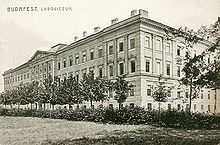Ludovika Academy
The Royal Hungarian Ludovika Academy, originally called Ludoviceum , was a cadet school - from 1897 a military academy - in Pest, Hungary (later Budapest ). In addition, there was a Landwehr secondary school in Sopron and two Landwehr cadet schools.
function
The academy was a foundation for the training of professional officers primarily for the ku Landwehr . However, the graduates could also apply for service with the joint army . From 1872 to 1897 it had the status of a cadet school in which 14- to 17-year-old pupils were accepted as convents (free of charge) or as pay pupils. 90 pupils were admitted annually. There were four cohorts and afterwards the pupils were retired from the troops as cadet sergeants and, with very good success, as cadet officers' deputies . The two best of the year were retired as lieutenants . In 1897 the Ludovika Academy was then put on an equal footing with the Theresian Military Academy in Wiener Neustadt in all respects and so all graduates were retired from the troops as lieutenants.
uniform
The uniform of the pupils corresponded in color and cut of the royal Hungarian Landwehr. The headgear was a dark blue shako with a gold silk border. The dark blue tunic ( dolman ) had a soft red collar and sleeve ties, the uniform trousers had madder red passepoils .
history
The Ludovika Academy was founded in 1808 (7th article of the law) by the Hungarian Diet . She got her name from Maria Ludovika , the third wife of the Austrian Emperor Franz I (in Hungary King Ferenc I).
The Hungarian coronation gift of 50,000 forints was donated by Maria Ludovika for the establishment of the academy. Although other donors, mainly from the Hungarian aristocracy, donated much larger amounts (e.g. 126,000 forints from Count János Buttler), the academy was called the Ludovika Academy out of loyalty to the ruling family. Several families donated land for the construction of a suitable building complex.
The building is a two-story building in the classical style, which was planned by the architect Mihály Pollack . The original chapel inside the building (1836–37) was made by Ferenc Uhr. In 1880 the building was extended by a new side building by the architect Joseph Kauser . Construction work began as early as the 1820s, despite the financial scarcity.
Sufficient funds were not available until 1830, so that the Hungarian palatine Archduke Joseph (Hungarian: József nador) was able to lay the foundation stone on June 28, 1830. However, the Hungarian government subsequently boycotted the project because they wanted to use the money elsewhere. It took until 1839 for the building complex to be completed. But the opening of the academy was delayed until the beginning of 1849.
The opening of the academy was further delayed by the revolution of 1848 . The Hungarians had risen against the ruling family and an imperial army had defeated the Magyars with the help of the Russian tsar . The academy was only able to start operations on November 21, 1872.
In 1897 it was assimilated to the Theresian Military Academy in Wiener Neustadt and existed until the end of the Habsburg Monarchy . During the Soviet Republic , the academy was closed and only reopened under the government of Admiral Horthy . At the end of 1944 the academy in Budapest was closed and moved to Kőszeg . After the Second World War , the academy was dissolved and had to cease operations entirely; she was not resuscitated.
The building complex still exists today on Ludovikaplatz in Josephstadt (8th district in Budapest) and today houses the humanistic grammar school Wallenberg , as well as parts of the Hungarian natural science museum .
literature
- Budapest Lexicon. Budapest 1993, Vol. 2, pp. 41f, ISBN 963-05-6411-4 ( Hungarian )
- Gerhard Janaczek: Efficient Officirs and Righteous Men. A historical picture journey to the military educational institutions of the k. (U.) K. Monarchy. Vitalis Verlag, Furth im Wald 2007, ISBN 978-3-89919-080-9 .
See also
Web links
Coordinates: 47 ° 28 ′ 54 ″ N , 19 ° 5 ′ 8 ″ E
Individual evidence
- ↑ The monument is the work of the Hungarian sculptor Adolf Bassler and was erected in 1903 in the garden of the Ludoviceum. In 1919, at the time of the Hungarian Soviet Republic , the monument was badly damaged and removed. In the following years it was restored by the Hungarian sculptor Viktor Vass (1873–1955) and placed again in 1929 on the same spot. During the time of communist rule in Hungary, it was removed again after 1945 and only returned to its original place after the fall of the Wall in 1992.
- ↑ Count János Buttler (1773-1845) was a wealthy Hungarian aristocrat. For the construction of the military academy he donated an amount of 126,000 guilders from his private fortune for its construction.




